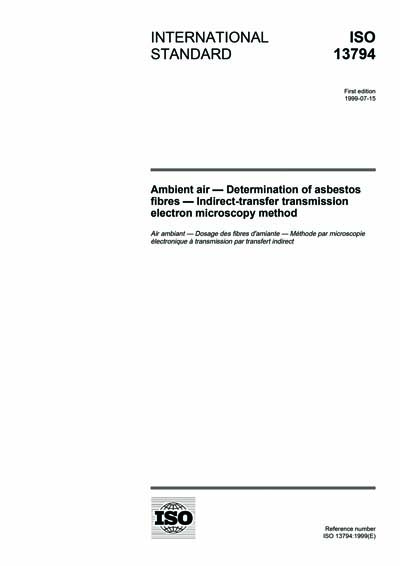Historical
ISO 13794:1999
Ambient air - Determination of asbestos fibres - Indirect-transfer transmission electron microscopy method
This International Standard specifies a reference method using transmission electron microscopy (TEM) for determination of the concentration of asbestos structures in ambient atmospheres. The specimen preparation procedure incorporates ashing and dispersion of the collected particulate, so that all asbestos is measured, including the asbestos originally incorporated in particle aggregates or particles of composite materials. The lengths, widths and aspect ratios of the asbestos fibres and bundles are measured, and these, together with the density of the type of asbestos, also allow the total mass concentration of airborne asbestos to be calculated. The method allows determination of the type(s) of asbestos fibre present. The method cannot discriminate between individual fibres of the asbestos and non-asbestos analogues of the same amphibole mineral.
The method is defined for polycarbonate capillary-pore filters or cellulose ester (either mixed esters of cellulose or cellulose nitrate) filters through which a known volume of air has been drawn. The method is suitable for determination of asbestos in both exterior and building atmospheres.
The upper limit for the range of concentration that can be measured on the analytical filter is 7000 structures/mm2. The lower limit of the range that can be measured on the analytical filter corresponds to detection of 2,99 structures in the area of specimen examined. The air concentrations represented by these values are a function of the volume of air sampled and the degree of dilution or concentration selected during the specimen preparation procedures. The method is particularly applicable for measurements in areas with high suspended-particulate concentrations (exceeding 10 μg/m3), or where detection and identification of asbestos fibres are likely to be prevented or hindered by other types of particulate in direct-transfer TEM preparations. In theory, there is no lower limit to the dimensions of asbestos fibres which can be detected. In practice, microscopists vary in their ability to detect very small asbestos fibres. Therefore, a minimum length of 0,5 μm has been defined as the shortest fibre to be incorporated in the reported results.
The limit of detection theoretically can be lowered indefinitely by filtration of progressively larger volumes of air, concentrating the sample during specimen preparation, and by extending the examination of the specimens in the electron microscope. In practice, the lowest achievable limit of detection for a particular area of TEM specimen examined is controlled by the total suspended particulate concentration remaining after the ashing and aqueous dispersal steps, and this depends on the chemical nature of the suspended particulate. For total suspended particulate concentrations of approximately 10 μg/m3, corresponding to clean, rural atmospheres, and assuming filtration of 4 000 litres of air, an analytical sensitivity of 0,5 structure/litre can be obtained, equivalent to a limit of detection of 1,8 structures/litre, if an area of 0,195 mm2 of the TEM specimens is examined. Lower limits of detection can be achieved by increasing the area of the TEM specimen that is examined, or by concentration of the sample during specimen preparation. In order to achieve lower limits of detection for fibres and bundles longer than 5 μm, and for PCM-equivalent fibres, lower magnifications are specified which permit more rapid examination of larger areas of the TEM specimens when the examination is limited to these dimensions of fibre.
International Organization for Standardization [iso]


